» posted on Sunday, September 11th, 2022 by Linda Lou Burton
Benjamin and the Green Chair
 Linda Lou Burton posting from Nairobi, Kenya – I saw him bringing a chair as I approached the house. By the time I was there, he’d made a perfect spot for me. At last, I was seated on Karen Blixen’s verandah! Here’s me, holding the book Karen Blixen wrote; which was the inspiration that brought me here to Nairobi. I wanted to see what Karen saw. I wanted to see Africa. Now, here I was, looking out over the wide lawn, seated in a green plastic chair, all mixed up with emotions. “The past is never past,” it’s been said, and by golly, it’s true. The past is only how we remember it, and even that changes over time. When Karen wrote Out of Africa she was already back in Denmark, recalling moments that were precious to her; or heart-wrenchingly sad. Chapter titles reveal her swings in thought: The Ngong Farm. A Native Child. A Gazelle. Riding in the Reserve. The Shooting Accident. Big Dances. A Kikuyu Chief. Somali Women. Old Knudsen. Visits of Friends.
Linda Lou Burton posting from Nairobi, Kenya – I saw him bringing a chair as I approached the house. By the time I was there, he’d made a perfect spot for me. At last, I was seated on Karen Blixen’s verandah! Here’s me, holding the book Karen Blixen wrote; which was the inspiration that brought me here to Nairobi. I wanted to see what Karen saw. I wanted to see Africa. Now, here I was, looking out over the wide lawn, seated in a green plastic chair, all mixed up with emotions. “The past is never past,” it’s been said, and by golly, it’s true. The past is only how we remember it, and even that changes over time. When Karen wrote Out of Africa she was already back in Denmark, recalling moments that were precious to her; or heart-wrenchingly sad. Chapter titles reveal her swings in thought: The Ngong Farm. A Native Child. A Gazelle. Riding in the Reserve. The Shooting Accident. Big Dances. A Kikuyu Chief. Somali Women. Old Knudsen. Visits of Friends.
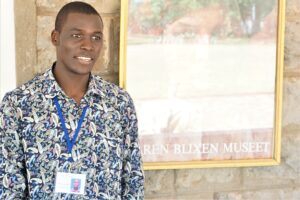 I’d come to see what I could see TODAY, that linked to Karen’s memories, and Benjamin was geared to tell. Benjamin was a handsome young man, a college student being funded by his work at the Museum. He knew his stuff; I’ve been studying Karen Blixen’s story for a long time, yet he told things I’d never heard before as he pointed to various posters displayed on the porch. Then it was time to go inside.
I’d come to see what I could see TODAY, that linked to Karen’s memories, and Benjamin was geared to tell. Benjamin was a handsome young man, a college student being funded by his work at the Museum. He knew his stuff; I’ve been studying Karen Blixen’s story for a long time, yet he told things I’d never heard before as he pointed to various posters displayed on the porch. Then it was time to go inside.
House Museums are generally stingy with what they allow visitors to do; and this was no exception. “No pictures,” Benjamin said, “but I’m bringing this chair inside so you can comfortably sit and hear what I say.” He led the way, green chair in hand, as we started out in the drawing room. My visions of the house (as I read the book) were completely dominated by the images in the 1985 Streep/Redford movie, and Benjamin assured us they were “basically” correct. Kumante Gatura, a Kikuyu who entered Karen’s life as a small boy and worked in the house until she left, was alive and on set during the movie-making, and gave his advice as to the correctness of what Sydney Pollack was trying to do.
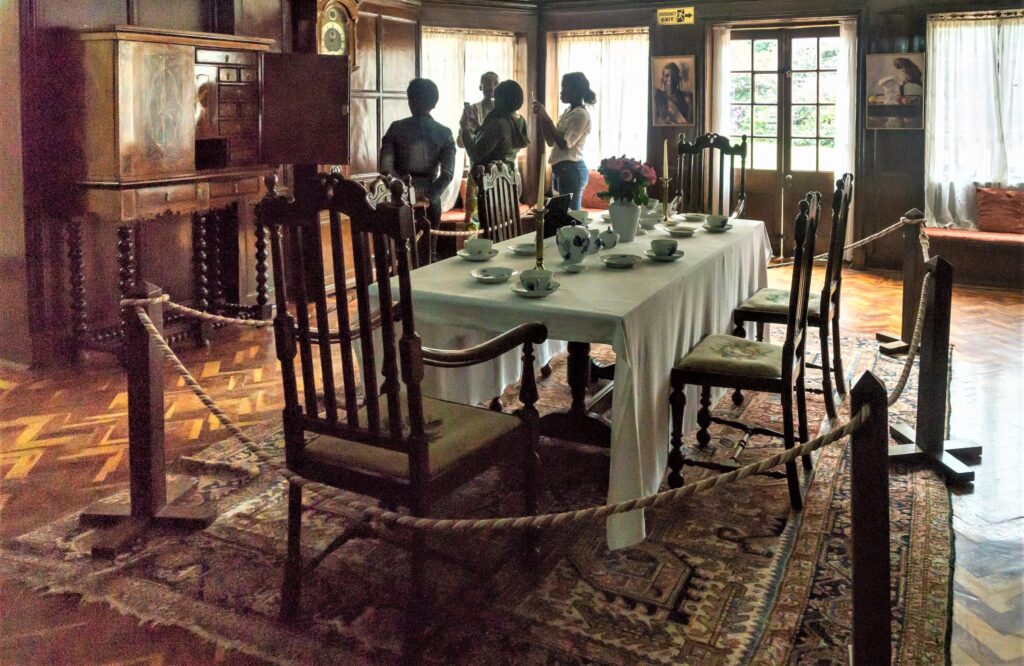 Benjamin moved my green chair from room to room, where I sat (and Rick stood) as he pointed out details – the dining table where Prince Edward sat during his 1928 visit; the desk where Karen sat to manage farm business, the cuckoo clock the children sneaked in to watch, the lion-skin rug. He had a story to tell about each, and he told each one with vigor, putting us there, in the moment. I wish I could show you what I saw, but I obeyed the rules. Which means, of course, any “inside photos” are lifted off a google search.
Benjamin moved my green chair from room to room, where I sat (and Rick stood) as he pointed out details – the dining table where Prince Edward sat during his 1928 visit; the desk where Karen sat to manage farm business, the cuckoo clock the children sneaked in to watch, the lion-skin rug. He had a story to tell about each, and he told each one with vigor, putting us there, in the moment. I wish I could show you what I saw, but I obeyed the rules. Which means, of course, any “inside photos” are lifted off a google search.
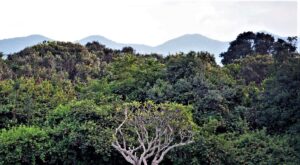 And then we were back outside, walking the grounds. Benjamin showed us how coffee beans grow on a tree (yes, one or two trees were left near the house). He pointed to the hills visible beyond the trees. “Those are the Ngong Hills Karen wrote about,” he said, “and that’s where Denys is buried. Ngong is a Swahili word for knuckles,” Benjamin
And then we were back outside, walking the grounds. Benjamin showed us how coffee beans grow on a tree (yes, one or two trees were left near the house). He pointed to the hills visible beyond the trees. “Those are the Ngong Hills Karen wrote about,” he said, “and that’s where Denys is buried. Ngong is a Swahili word for knuckles,” Benjamin 
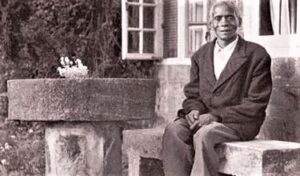 explained, holding up his folded hand to show the knuckles matching the hills in the distance. The large stone terrace at the back of the house is where Karen held “clinic” every morning at 9, Benjamin pointed out, dispensing first aid as needed to the natives who worked on her farm. Kumante helped with this every day. Rick and I posed for a picture between the two large millstone tables where they sat. I found a picture (online) of Kumante as an old man, sitting back there. I’m guessing it was when he came to assist in the movie-making.
explained, holding up his folded hand to show the knuckles matching the hills in the distance. The large stone terrace at the back of the house is where Karen held “clinic” every morning at 9, Benjamin pointed out, dispensing first aid as needed to the natives who worked on her farm. Kumante helped with this every day. Rick and I posed for a picture between the two large millstone tables where they sat. I found a picture (online) of Kumante as an old man, sitting back there. I’m guessing it was when he came to assist in the movie-making.
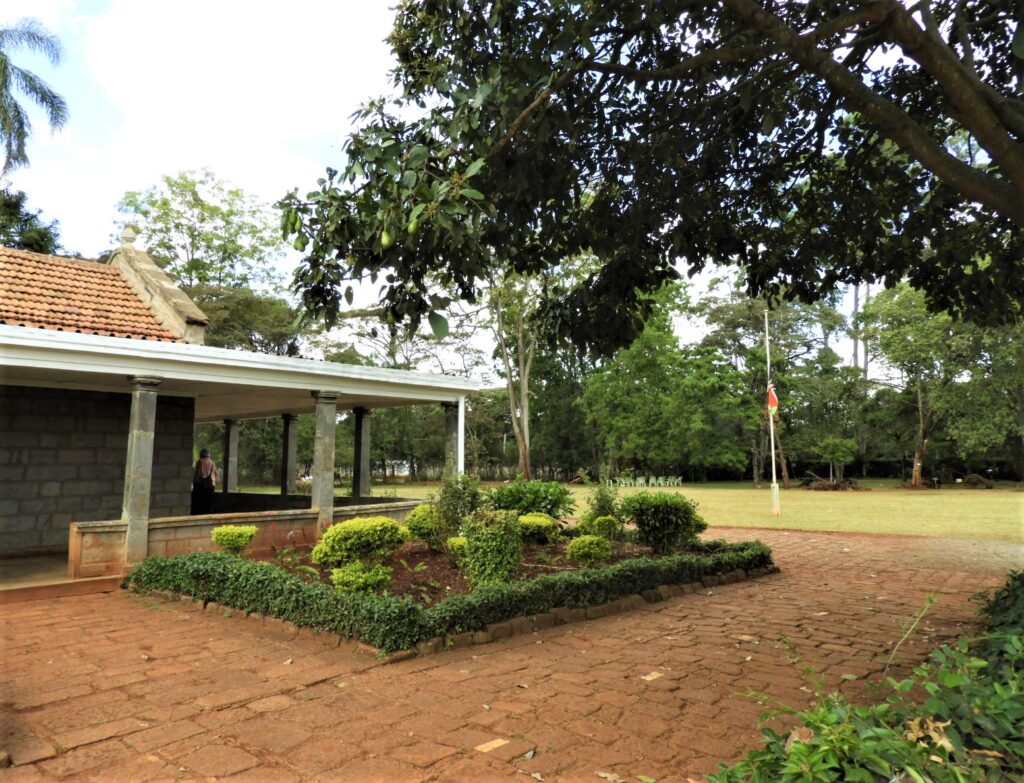 We completed our walk around the house, imagining the crowds gathered there daily, the workers, the children playing, the goats grazing. Here is where the big natives dances (ngomas) were held, with as many as a thousand Maasai coming to celebrate. Here is where Karen sat with Denys, listening to Mozart on the victrola he brought her. Here is where Karen’s belongings were sold when she lost the farm, and here is the last thing Karen saw, that day in 1931 when she had to leave Africa forever.
We completed our walk around the house, imagining the crowds gathered there daily, the workers, the children playing, the goats grazing. Here is where the big natives dances (ngomas) were held, with as many as a thousand Maasai coming to celebrate. Here is where Karen sat with Denys, listening to Mozart on the victrola he brought her. Here is where Karen’s belongings were sold when she lost the farm, and here is the last thing Karen saw, that day in 1931 when she had to leave Africa forever.
 Our tour of the Karen Blixen Museum was over. I complimented Benjamin for the excellent presentation he made, thanked him for for the kindness of the green chair, wished him well. Rick waved to Daniel, and Blethwell, who were waiting with our vehicle just down the drive. We were quiet on the ride through the Karen suburb back to our hotel on Kenyatta Avenue, just thinking, I guess.
Our tour of the Karen Blixen Museum was over. I complimented Benjamin for the excellent presentation he made, thanked him for for the kindness of the green chair, wished him well. Rick waved to Daniel, and Blethwell, who were waiting with our vehicle just down the drive. We were quiet on the ride through the Karen suburb back to our hotel on Kenyatta Avenue, just thinking, I guess.
Karen Blixen Museum, Karen Road, Nairobi https://www.kenyamuseumsociety.org/karen-blixen-museum/
Residence in Kenya 1914-1931
Out of Africa published 1937

